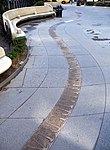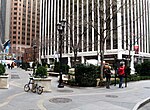20 Exchange Place

20 Exchange Place, formerly the City Bank–Farmers Trust Building, is a skyscraper in the Financial District of Lower Manhattan in New York City. Completed in 1931, it was designed by Cross & Cross in the Art Deco style as the headquarters of the City Bank–Farmers Trust Company, predecessor of Citigroup. The building, standing at approximately 741 feet (226 m) with 57 usable stories, was one of the city's tallest buildings and the world's tallest stone-clad building at the time of its completion. While 20 Exchange Place was intended to be the world's tallest building at the time of its construction, the Great Depression resulted in the current scaled-back plan. The building has a granite and limestone facade, while its internal superstructure is made of steel. The lower section of the facade fills an entire irregular city block, and contains giant piers supporting standalone figures depicting the "giants of finance", as well as decorations designed by David Evans. The main entrance on Exchange Place has a round arch with granite medallions representing the countries where City Bank Farmers Trust operated offices. The upper stories rise as a square tower with chamfered corners and is offset from the base. The City Bank–Farmers Trust Building was built between 1930 and 1931, for the newly merged National City Bank of New York and the Farmers' Loan and Trust Company. It remained the company's headquarters until 1956 and was ultimately sold in 1979. The 16th through 57th floors of the building were converted from commercial to residential space by Metro Loft Management during the 1990s. The New York City Landmarks Preservation Commission designated 20 Exchange Place as an official city landmark in 1996. It is also a contributing property to the Wall Street Historic District, a National Register of Historic Places district created in 2007.
Excerpt from the Wikipedia article 20 Exchange Place (License: CC BY-SA 3.0, Authors, Images).20 Exchange Place
Exchange Place, New York Manhattan
Geographical coordinates (GPS) Address External links Nearby Places Show on map
Geographical coordinates (GPS)
| Latitude | Longitude |
|---|---|
| N 40.705555555556 ° | E -74.009722222222 ° |
Address
20 Exchange Place
Exchange Place 20
10004 New York, Manhattan
New York, United States
Open on Google Maps










